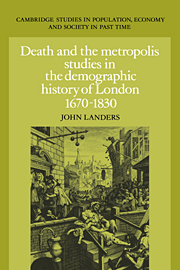Book contents
- Frontmatter
- Contents
- List of figures and maps
- List of tables
- Preface
- Acknowledgements
- Part I EIGHTEENTH-CENTURY LONDON AND ITS VITAL REGIME
- Part II THE LEVEL OF MORTALITY
- Part III DIMENSIONS OF LONDON'S EPIDEMIOLOGICAL REGIME
- 6 The seasonality of mortality
- 7 The instability of mortality
- 8 Spatial variations in mortality
- 9 Conclusion
- Appendices
- Bibliography
- Index
- Cambridge Studies in Population Economy and Society in Past Time
8 - Spatial variations in mortality
Published online by Cambridge University Press: 05 November 2011
- Frontmatter
- Contents
- List of figures and maps
- List of tables
- Preface
- Acknowledgements
- Part I EIGHTEENTH-CENTURY LONDON AND ITS VITAL REGIME
- Part II THE LEVEL OF MORTALITY
- Part III DIMENSIONS OF LONDON'S EPIDEMIOLOGICAL REGIME
- 6 The seasonality of mortality
- 7 The instability of mortality
- 8 Spatial variations in mortality
- 9 Conclusion
- Appendices
- Bibliography
- Index
- Cambridge Studies in Population Economy and Society in Past Time
Summary
In the last chapter we argued that the proximate determinants of short-run mortality change were to be found in changing levels of exposure to infection and in aggregate shifts in the population's immunological resistance. Both of these were mediated by changes in spatial structure, and in particular by changes in housing densities and migration streams. We saw in chapter 2 that London was spatially differentiated in both these respects. Housing conditions differed substantially in different parts of the capital, and these differences widened with the development of the aristocratic districts to the west. Similarly, the distribution of recent immigrants was spatially uneven. The inner suburbs were apparently the main receiving areas for much of the period, although we have much less data on this topic and it is harder to track developments over time.
Thus, if the argument of the previous chapter is correct, we should expect mortality in different parts of London to display different levels and forms of instability. Furthermore, to the extent that housing conditions and migration patterns also influenced secular mortality patterns, we should expect London's epidemiological regime to display a more general pattern of spatial differentiation (or ‘segmentation’) with respect to these variables. Hitherto our population has, for the most part, been treated as though it were a single homogeneous entity, differentiated only by the demographic criteria of age, sex and migratory status.
- Type
- Chapter
- Information
- Death and the MetropolisStudies in the Demographic History of London, 1670–1830, pp. 301 - 350Publisher: Cambridge University PressPrint publication year: 1993
- 1
- Cited by



